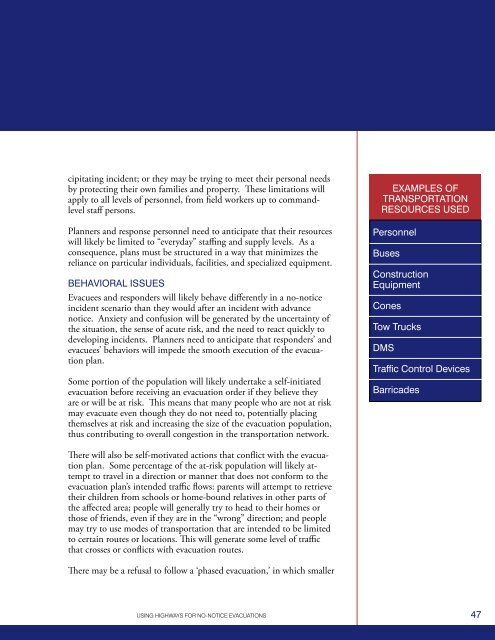using highways for no-notice evacuations - FHWA Operations - U.S. ...
using highways for no-notice evacuations - FHWA Operations - U.S. ...
using highways for no-notice evacuations - FHWA Operations - U.S. ...
You also want an ePaper? Increase the reach of your titles
YUMPU automatically turns print PDFs into web optimized ePapers that Google loves.
cipitating incident; or they may be trying to meet their personal needsby protecting their own families and property. These limitations willapply to all levels of personnel, from field workers up to commandlevelstaff persons.Planners and response personnel need to anticipate that their resourceswill likely be limited to “everyday” staffing and supply levels. As aconsequence, plans must be structured in a way that minimizes thereliance on particular individuals, facilities, and specialized equipment.behavioral issuesEvacuees and responders will likely behave differently in a <strong>no</strong>-<strong>no</strong>ticeincident scenario than they would after an incident with advance<strong>no</strong>tice. Anxiety and confusion will be generated by the uncertainty ofthe situation, the sense of acute risk, and the need to react quickly todeveloping incidents. Planners need to anticipate that responders’ andevacuees’ behaviors will impede the smooth execution of the evacuationplan.Some portion of the population will likely undertake a self-initiatedevacuation be<strong>for</strong>e receiving an evacuation order if they believe theyare or will be at risk. This means that many people who are <strong>no</strong>t at riskmay evacuate even though they do <strong>no</strong>t need to, potentially placingthemselves at risk and increasing the size of the evacuation population,thus contributing to overall congestion in the transportation network.Examples ofTransportationResources UsedPersonnelBusesConstructionEquipmentConesTow TrucksDMSTraffic Control DevicesBarricadesThere will also be self-motivated actions that conflict with the evacuationplan. Some percentage of the at-risk population will likely attemptto travel in a direction or manner that does <strong>no</strong>t con<strong>for</strong>m to theevacuation plan’s intended traffic flows: parents will attempt to retrievetheir children from schools or home-bound relatives in other parts ofthe affected area; people will generally try to head to their homes orthose of friends, even if they are in the “wrong” direction; and peoplemay try to use modes of transportation that are intended to be limitedto certain routes or locations. This will generate some level of trafficthat crosses or conflicts with evacuation routes.There may be a refusal to follow a ‘phased evacuation,’ in which smallerUSING HIGHWAYS FOR NO-NOTICE EVACUATIONS47
















